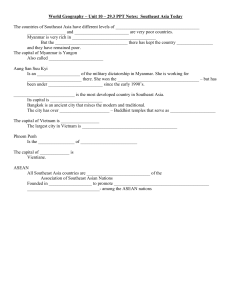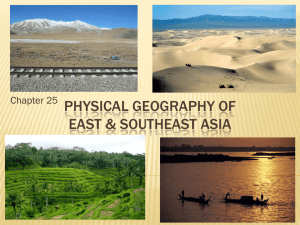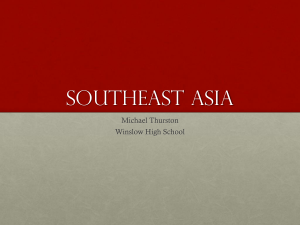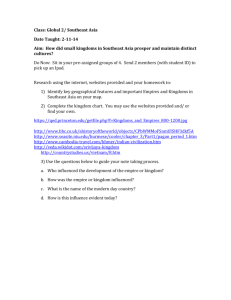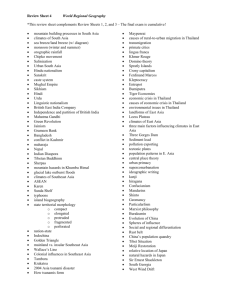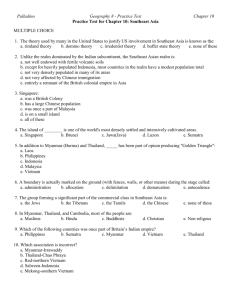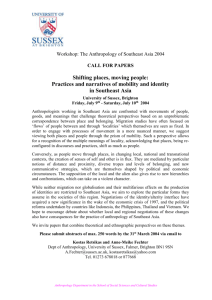Chapter 29: The Physical Geography of Southeast Asia
advertisement
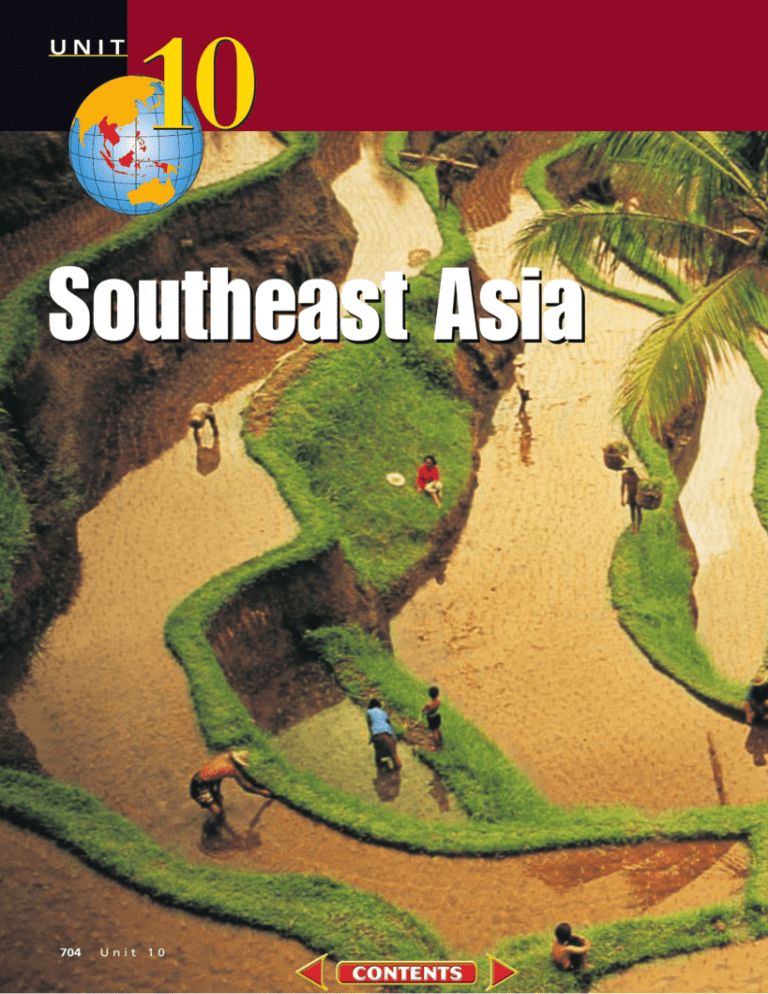
UNIT 10 Southeast Asia 704 Unit 10 NGS ONLINE www.nationalgeographic.com/education WHY IT’S IMPORTANT— Southeast Asia is a vital crossroads of trade and commerce.The region is rich in natural resources such as tin, petroleum, rubber, tea, spices, and valuable woods. In recent years, many Southeast Asians have migrated to the United States, bringing their own religions and cultures with them.You are probably familiar with the flavors of many Southeast Asian dishes, available now in restaurants in the United States. World Regions Video To learn more about Southeast Asia and its impact on your world, view the World Regions video “Southeast Asia.” Terraced rice fields on the island of Bali, Indonesia Unit 10 705 UNIT 10 REGIONAL ATLAS What Makes Southeast Asia a Region? ying east of India and south of China, Southeast Asia juts out from the rest of the Asian continent and then fragments into a jumble of islands that straddle the Equator. Two peninsulas form the mainland—the bulbous Indochina Peninsula and the narrow Malay Peninsula, which extends southward from the other like a long, gnarled finger. Millions of years ago, tectonic plates collided to form parallel mountain ranges that span the mainland from north to south. Great rivers, such as the Irrawaddy, Mekong, Chao Phraya, and Red, course through the valleys between these ranges and create fertile deltas where they meet the sea. Most of the region’s islands are mountainous, too, but their peaks were spawned by ancient volcanic eruptions. Active volcanoes remain a threat on these islands, which lie along the Pacific Ring of Fire. Rain forests cover parts of Southeast Asia.Watered by monsoon rains, these forests—valued for their timber and wildlife—are decreasing because of extensive logging. L 2 1 1 Ankle-deep in muddy water, a Philippine farmer plants rice seedlings in a flooded paddy. Southeast Asia’s fertile soils and warm, wet climate are ideal for growing rice. Most farmers in Southeast Asia plant and harvest their crops by hand. 706 Unit 10 3 4 2 Using trunk and tusks, an Asian elephant piles up teak logs along a river in Myanmar. The lush forests of this country supply more than three-fourths of the world’s teak, a beautiful, durable wood often used for furniture. Some Southeast Asian loggers use tractors, but elephants are cheaper and don’t require roads. 3 Steering with slender paddles, a Vietnamese woman guides her boat through a shallow waterway on the delta of the Mekong River. From its source in China, the Mekong flows 2,600 miles (4,180 km) to the South China Sea. Like rivers throughout this region, the Mekong is a vital transportation route for people and goods. 4 Like a fountain of fire, Krakatau hurls lava into the night sky. One of Indonesia’s many active volcanoes, Krakatau lies between the islands of Sumatra and Java. In 1883, 36,000 people died when Krakatau erupted violently, generating huge tidal waves that swept over the nearby islands. Unit 10 707 UNIT 10 REGIONAL ATLAS Ethnic Mosaic Rugged mountains and rolling seas could not hold back the outsiders that have been drawn to Southeast Asia throughout its history. Some came to trade, some to settle, and others to forge empires. Beginning in the 1500s, Europeans laid claim to various parts of the region. Eventually, every Southeast Asian country except Thailand was a European colony. Colonial rule ended in the mid-1900s, but the region was left fragmented and in turmoil. Struggles among ethnic groups and between Communist and non-Communist powers claimed thousands of lives. Today, more than 500 million people live in this culturally diverse region.They speak hundreds of languages and dialects and practice several major religions. Despite rapid urbanization and industrialization in some places, most Southeast 1 Asians still make their living traditionally, as farmers. 1 A white scarf covers the head of a Muslim girl in Malaysia. Arab and Indian traders brought the faith of Islam to Southeast Asia in the 1300s and 1400s. Today, Islam is the dominant religion on the Malay Peninsula and in Indonesia. In fact, Indonesia has more Muslims than any other country in the world. 708 Unit 10 2 3 4 2 Fruit vendors on bicycles offer bounty from the fields to buyers on the streets of Hanoi, Vietnam. Most Vietnamese, like other Southeast Asians, are farmers who raise rice, fruit, and other crops on small plots of land. Only a small percentage of Vietnamese people work in industry. 3 Beneath gilded towers, Buddhist monks descend the steps of a temple in Vientiane, the capital and largest city of Laos. After Islam, Buddhism is the second most widespread religion in Southeast Asia. It is the primary religion in Laos and on the rest of the Indochina Peninsula. 4 Southeast Asia’s busiest port, Singapore lies at the tip of the Malay Peninsula, along the Strait of Malacca, the main shipping route between the Indian Ocean and the South China Sea. From this strategic location, the city handles much of the flow of goods into and out of Southeast Asia. UNIT REGIONAL ATLAS 10 Southeast Asia PHYSICAL 100°E 110°E 120°E 130°E 140°E EAST ASIA Na g 30°N ill s aH TROPIC OF CANCER N it Co a m Gulf of Tonkin rd Paracel THAILAND M KHORAT Islands PLATEAU VIETNAM k R a. Dangre CAMBODIA Luzon Philippine Sea Ch era R. ong ek ill aung aukt Bil Range Chao Phraya R. Ra. en an LAOS na Salween T R. ra St on z Lu R. a S e An Bay of Bengal . yR n Yo m a ka I r r awa d d Ara 20°N Re d in MYANMAR Shan Plateau rim at aS . J a v a ea aS cc M Celebes (Sulawesi) G R E AT E R S e a Java Ocean 0 mi. Elevation Profile u Moluccas New Guinea Ceram Sea Ceram I N D O N E S I A Aru Is. Jaya Peak 16,500 ft. (5,029 m) Flores Sea Bali 500 26,247 ft IRRAWADDY 0 km 500 19,685 ft 6,000 m RIVER MEKONG ANNAM 4,000 m RIVER CORDILLERA 13,123 ft Yangon 6,562 ft 2,000 m (Rangoon) GULF OF BAYOF TONKIN BENGAL Sea level ol Banda Sea SUNDA ISLANDS Indian 10°Sm 8,000 tr . Borneo Ka ts SINGAPORE Mak ass ar Str ait EQUATOR ra M at n m risa S u Ba 0° th Mindoro Samar Tonle Andaman P HILIPPINES Sap u o Leyte Spratly Sea Palawan S Isthmus Gulf 10°N of Negros Mekong of Islands Kra Thailand River Delta Sulu l Mindanao Str. Sea ne b ac an S ala h B tra C it eat BRUNEI Gr of M M A L A Y S I A al Celebes ac Natuna ca Malay Sea Peninsula Is. Pacific Ocean Le sse Savu Sea EAST TIMOR A r a f u r a S e a r Sunda Islan ds Timor Sea 0 mi. 400 F.P.O 0 km 400 Miller Cylindrical projection AUSTRALIA POLITICAL 100°E 110°E 120°E 130°E 140°E National capital Territorial capital Major city EAST ASIA 30°N 0 mi. 400 0 km 400 Miller Cylindrical projection TROPIC OF CANCER MYANMAR . yR Salween R. LAOS Luzon Strait Gulf of Tonkin ILLERA RD CO R. AM N ek o n g AN M I r r awa d d 20°N N Hanoi Vientiane Gulf of Martaban China Manila Sulu Sea Bandar Seri BRUNEI Begawan M R. as BORNEO at kas s rim RA Ka AT Kap u J a v a Jakarta Bandung Molucca Sea MOLUCCAS CELEBES Ceram Sea Ma it tra aS Indian Ocean Celebes Sea ar Str ait Kuala L. Toba Lumpur SINGAPORE SU EQUATOR MINDANAO Balabac Strait MALAY PENINSULA NEW GUINEA S e a I N JAVA Pacific Ocean PHILIPPINES M A L A Y S I A 0° Philippine Sea Sea Bangkok CAMBODIA Phnom VIETNAM Penh Gulf of Andaman Thailand Ho Chi Minh City Sea Isthmus 10°N of Kra eat l Gr anne h C LUZON South Yangon THAILAND (Rangoon) Banda Sea D Surabaya O N E S Savu Sea MAP Study I A Flores Sea Dili Arafura Sea EAST TIMOR Timor Sea 1. What are the capitals of the continental countries in Southeast Asia? AUSTRALIA 2. To what country does the island of Mindanao belong? Unit 10 711 UNIT REGIONAL ATLAS 10 Southeast Asia POPULATION DENSITY 100°E 110°E 120°E 140°E EAST ASIA 30°N Per sq. km Per sq. mi. Over 100 Over 250 50–100 125–250 25–50 60–125 1–25 TROPIC OF CANCER2–60 Under 1 Under 2 Uninhabited Uninhabited TROPIC OF CANCER Mandalay Hanoi Haiphong Gulf of Tonkin Chiang Vientiane Mai Sittwe 20°N Yangon (Rangoon) Luzon Strait S e a Da Nang Bangkok at G re Ch an a C Kuala Lumpur S o u Cebu Ka rim at Padang h t Sulu Balabac Strait Sea Kuching Pontianak Molucca Sea Samarinda a St t N Pacific Ocean Bandar Seri Begawan ra Banjarmasin i J a v a S e a Makassar Jakarta Semarang Bandung Surabaya Flores Sea Palembang Cagayan de Oro Davao Celebes Sea Singapore EQUATOR 0° Quezon City Manila i Ho Chi Minh City l ne Medan Over 5,000,000 2,000,000 –5,000,000 1,000,000 –2,000,000 250,000 –1,000,000 Under 250,000 Philippine Sea n Gulf of Thailand h 10°N Phnom Penh Andaman Sea Cities (Statistics reflect metropolitan areas.) Mataram 10°S Ceram Sea Jayapura Kendari Banda Sea Dili Savu Sea Timor Sea Arafura Sea Indian 0 mi. 400 0 km 400 Miller Cylindrical projection 712 Unit 10 Ocean AUSTRALIA ECONOMIC ACTIVITY 100°E 110°E 120°E 130°E 140°E Resources EAST ASIA Petroleum Natural gas 30°N Coal N Nickel Tungsten Copper TROPIC OF CANCER Tin 20°N MYANMAR Teak Teak Yangon (Rangoon) Rice Hanoi L A O S Rice Gulf of Tonkin Rubber 10°N Andaman Sea Rice CAMBODIA Phnom Gulf of Penh Gold South THAILAND Rice Rice Bangkok China Land Use Philippine Sugarcane Se a Manila Se a PHILIPPINES Ho Chi Minh City N N Sulu Sea Tea Kuala Medan Lumpur BRUNEI SU Coconuts Rubber Pearls BORNEO rim RA Ka AT Indian Ocean Palembang Spices it tra aS Coconuts J a v a Jakarta Bandung Spices N N at N Coffee Pacific Ocean SINGAPORE Rice M 0° Coconuts Abaca Corn Celebes Sea M A L A Y S I A Rubber EQUATOR Commercial farming Subsistence farming Hunting and gathering Manufacturing and trade Commercial fishing VIETNAM Rice Thailand Gemstones Luzon Strait CELEBES Rubber Spices Spices S e a JAVA I Banda Sea N D Surabaya Cassava 10°S MAP Study 1. Which Southeast Asian countries have deposits of gold? Gemstones? 0 mi. O N E S I NEW GUINEA Coconuts A Coconuts Pearls EAST TIMOR A r a f u r a Se a 400 0 km 400 Miller Cylindrical projection AUSTRALIA 2. Which Southeast Asian island countries are the most densely populated? Unit 10 713 UNIT 10 REGIONAL ATLAS Southeast Asia FOR AN ONLINE UPDATE OF THIS INFORMATION, VISIT GEOGRAPHY.GLENCOE.COM AND CLICK ON “TEXTBOOK UPDATES.” COUNTRY PROFILES COUNTRY * AND CAPITAL FLAG AND LANGUAGE POPULATION AND DENSITY MAJOR EXPORT MAJOR IMPORT Crude Oil Machinery Brunei Dollar Constitutional Monarchy 69,900 sq. mi. 181,041 sq. km Timber Construction Materials Riel Constitutional Monarchy 800,000 Tetun, Javanese, 134 per sq. mi. 52 per sq. km Portuguese 5,741 sq. mi. 14,869 sq. km Coconut Products Manufactured Goods Indonesian Rupiah Republic 206,100,000 Bahasa Indonesia, 280 per sq. mi. 108 per sq. km Javanese 735,355 sq. mi. 1,904,569 sq. km Crude Oil Manufactured Goods Rupiah Republic 91,429 sq. mi. 236,800 sq. km Wood Products Machinery Kip Communist State 22,700,000 178 per sq. mi. Malay, English, Chinese 69 per sq. km 127,317 sq. mi. 329,749 sq. km Electronic Equipment Machinery Ringgit Constitutional Monarchy 47,800,000 183 per sq. mi. Burmese, Local Languages 71 per sq. km 261,228 sq. mi. 676,581 sq. km Beans Machinery Kyat Military Dictatorship 77,200,000 666 per sq. mi. Tagalog, English 257 per sq. km 115,830 sq. mi. 300,000 sq. km Electronic Equipment Raw Materials Philippine Peso Republic Computer Equipment Aircraft Singapore Dollar Republic LANDMASS CURRENCY GOVERNMENT BRUNEI Bandar Seri Begawan 300,000 156 per sq. mi. Malay, English, Chinese 60 per sq. km 2,228 sq. mi. 5,771 sq. km CAMBODIA Phnom Penh Khmer, French 13,100,000 187 per sq. mi. 72 per sq. km EAST TIMOR Dili INDONESIA Jakarta LAOS Vientiane Lao, French 5,400,000 59 per sq. mi. 23 per sq. km MALAYSIA Kuala Lumpur MYANMAR Yangon (Rangoon) PHILIPPINES Manila SINGAPORE Singapore Chinese, Malay, Tamil, English 4,100,000 17,320 per sq. mi. 239 sq. mi. 6,687 per sq. km 619 sq. km THAILAND Bangkok VIETNAM 62,400,000 Thai, 315 per sq. mi. Local Languages 122 per sq. km 198,116 sq. mi. 513,120 sq. km Manufactured Goods Machinery Baht Constitutional Monarchy 78,700,000 623 per sq. mi. Vietnamese, Local Languages 241 per sq. km 128,066 sq. mi. 331,691 sq. km Crude Oil Machinery Dong Communist State Hanoi * 714 Unit 10 COUNTRIES AND FLAGS NOT DRAWN TO SCALE ▲ Ruins of Buddhist temple c. A.D. 1000–1200, Pagan, Myanmar Unit 10 715 UNIT 10 REGIONAL ATLAS GLOBAL CONNECTION SOUTHEAST ASIA AND THE UNITED STATES CUISINE What’s for dinner? Twenty or thirty years ago, the answer probably would have been “steak,”“meatloaf,” or “hamburgers.” But now, you might hear “lemon grass chicken” or “laab moo”! Americans have developed a taste for foods from other lands. And the cuisines of two Southeast Asian countries—Thailand and Vietnam— have become especially popular in the United States. Thai and Vietnamese cooks themselves have borrowed foods, flavors, and preparation methods from several of their neighbors, especially China and India. For example, many Thai and Vietnamese dishes are stir-fried, as is much Chinese food. Coconut milk is an ingredient picked up from India. Nevertheless,Thai and Vietnamese cuisines have their own distinctive flavors and characteristics. Some of the common ingredients in Thai food are lemon grass, shrimp paste, Siamese ginger, and chilies—very hot chilies! These and other ingredients are combined to create complex and tantalizing tastes. Laab moo, for example, is a dish of minced pork seasoned with lemon juice, fish sauce, fresh mint, and green chilies. In a Enjoying a meal in Hanoi, Vietnam single forkful of a Thai dish, you might taste sweet, sour, salty, and hot flavors all at once. Vietnamese food is often described as being similar to Thai food, but less intense, ▲ 716 Unit 10 ▲ Floating produce market in Thailand with more subtle flavors. Some Vietnamese dishes might seem more like salads than main dishes to most Americans. Bits of cooked meat or fish are typically served with a platter of fresh lettuce, herbs, and vegetables. One ingredient found in almost all Vietnamese dishes is nuoc mam, a salty fish sauce. What salt is to American food and soy sauce is to Chinese dishes, nuoc mam is to Vietnamese cuisine. How did Thai and Vietnamese foods get to the United States? In the 1970s, after the Vietnam War, Vietnamese refugees flocked to America. Many opened small restaurants. Thais had been coming to the United States as students since the 1960s. Many of the Thais settled in Los Angeles, where the climate may have reminded them of home. By 1990, there were more Thais living in greater Los Angeles than any other place outside Thailand—and the city had at least 200 Thai restaurants. Now Thai and Vietnamese restaurants can be found in cities all across the United States. From the fiery flavors of Thailand to the more delicate tastes of Vietnam, Southeast Asian cuisines have found a home in America. Unit 10 717 GeoJournal As you read the chapter, visualize places in Southeast Asia that are discussed in the chapter. Write entries in your journal that describe the region’s prominent physical features. Use vivid images and details in your entries. Chapter Overview Visit the Glencoe World Geography Web site at tx.geography.glencoe.com and click on Chapter Overviews—Chapter 29 to preview information about the physical geography of the region. Guide to Reading The Land Consider What You Know You have learned how the physical geography of a region affects its economy. Southeast Asia is rich in tropical rain forests and water resources. What products do you know about that come from this region? Read to Find Out • How did tectonic plate movement, volcanic activity, and earthquakes form Southeast Asia? • Why are the region’s waterways important to its peoples? • How do rich natural resources affect Southeast Asia’s economy? Terms to Know • cordillera • archipelago • insular • flora • fauna Places to Locate • Indochina Peninsula • Malay Peninsula A Geographic View Journey to the Interior At dawn the next day I set off upriver in a hollowed-out tree trunk with my guide. . . . [He] poles the dugout through the tea-colored water while I watch birds—kingfishers darting from the riverbanks, flocks of hornbills skimming above the treetops, their wings sounding like runners panting for breath. The banks sprout wild breadfruits, bananas, and a host of palm trees, all tangled up with hanging vines. As the heat of the day intensifies, the river’s Stilt ho uses in Irian Ja green walls vibrate with the ya ringing of cicadas. Then the river grows shallower, forcing us to push the dugout over rocks. It is the dry season, something hard to fathom in a place drenched with more than 200 inches of rain a year. —Thomas O’Neill, “Irian Jaya, Indonesia’s Wild Side,” National Geographic, February 1996 • Annam Cordillera • Irrawaddy River • Chao Phraya River • Red River • Mekong River Lush rain forests, tangled swamps, and rugged mountains characterize the province of Irian Jaya in the Southeast Asian country of Indonesia. In this section you will explore the physical geography of Southeast Asia: its beginnings, its natural barriers of mountains and water, its tempestuous volcanoes, and its abundant natural resources. Peninsulas and Islands Pura (temple) Ulun Danu, Bali, Indonesia When the Eurasian, Philippine, and Indo-Australian tectonic plates collided millions of years ago, they formed the landmasses that are known today as Southeast Asia. The upheaval formed cordilleras, Chapter 29 719 Hue, Vietnam Farmers tend their fields near Hue, a historic city in central Vietnam. Place What countries lie on the Indochina Peninsula? or parallel mountain ranges and plateaus, that extend into the Indochina Peninsula. Activity from related volcanoes and earthquakes created a series of archipelagos in the South Pacific. An archipelago is a group of islands. Straddling the Equator, the peninsulas and islands of Southeast Asia combine mountainous terrain with a predominantly tropical climate. The region stretches from the Asian mainland almost to Australia and covers 1,570,000 square miles (4,066,300 sq. km). Two large land areas, the Indochina Peninsula and the Malay Peninsula, make up mainland Southeast Asia. South and east of this area lies the vast Malay Archipelago, Southeast Asia is about half the size of the continental United States. 720 Unit 10 sometimes called the East Indies. The Malay Archipelago, containing 20,000 islands, stretches from the Indian Ocean to the Pacific Ocean. Mainland Southeast Asia About half of Southeast Asia’s 11 countries are located on the mainland. The rest are island countries, except for Malaysia, which is both a mainland and an island country. Laos is the region’s only country without a coastline. The four mainland countries of Vietnam, Laos, Cambodia, and Myanmar (formerly called Burma) lie entirely on the Indochina Peninsula. Most of Thailand also is located there, but part of that country trails southward to the Malay Peninsula. Malaysia shares the Malay Peninsula with Thailand, while the rest of Malaysia is located on Borneo, an island east of the Malay Peninsula. Island Southeast Asia The insular, or island, countries of Southeast Asia include Brunei, East Timor, Indonesia, Singapore, and the Philippines. Brunei, almost surrounded by Malaysia, is a small country on the northern coast of Borneo. Indonesia is the largest island country MAP STUDY Southeast Asia: Physical-Political 110°E Irra wad dy R. 90°E 130°E TROPIC OF CANCER Re M YA NM A R LAOS 20°N dR . Pa c i fic Oc ean M A IN CH DO I N ong R. ek Luzon South China Mt. Pinatubo Sea 5,248 ft. (1,600 m) ao Chya R. a P hr THAILAND CAMBODIA Isthmus of Kra N P H I L I P P I N ES VIETNAM 10°N Elevations Philippine Sea Gulf of Thailand Mindanao Malay Peninsula Feet 10,000 5,000 2,000 1,000 0 Meters 3,000 1,500 600 300 0 National boundary Mountain peak BRUNEI M A L A Y S I A 0° EQUATOR I ndian O c e an 0 mi. Borneo SINGAPORE 400 Sumatra Krakatau (Krakatoa) 0 km 400 Miller Cylindrical projection Jaya Peak 16,500 ft. (5,029 m) New Guinea Celebes I N D O N E S I A Java 10°S 1. Interpreting Maps What is the only landlocked country in Southeast Asia? EAS T T I MO R 2. Applying Geography Skills What challenge might Malaysia, Indonesia, and the Philippines face as island countries? Find NGS online map resources @ www.nationalgeographic.com/maps in the region. Its 13,677 islands span 3,000 miles (4,827 km) and two oceans, the Indian and the Pacific. Only about 6,000 islands are named, and fewer than 1,000 are permanently settled. East Timor, formerly a part of Indonesia, voted to become independent in 1999. Two years later, East Timorese held elections for a new national assembly. The country of Singapore, a collection of one large island and more than 50 smaller ones, sits just off the southern tip of the Malay Peninsula. The country’s capital is on the large island, and both the island and the capital city are called Singapore. The size of the islands varies greatly. The total area of the island of Singapore is 221 square miles (572 sq. km), and the total area of all the other islands is about 18 square miles (47 sq. km). Half of those islands are uninhabited. Although more than 7,000 islands make up the Philippines, only around 900 are settled, and 11 islands account for over 95 percent of the country’s area. As in Indonesia and Singapore, many of the Philippine islands have not been named. Chapter 29 721 Physical Features Cordilleras loom above fertile fields. Rivers create transportation routes through lush vegetation. Majestic volcanoes add to the scenery. These physical features create Southeast Asia’s colorful and varied landscapes. Ocean. These mountains are actually volcanoes, many of which are still active. Some islands of Indonesia and the Philippines are marked with craters formed by these volcanoes. Mineral-rich volcanic material that has broken down over the centuries has left rich, fertile soil, making Southeast Asia’s islands highly productive agricultural areas. Mountains Mountains dominate Southeast Asian landscapes, although most peaks crest below 10,000 feet (3,048 m). Throughout the region these mountains create geographic and political boundaries. The Indochina Peninsula’s western and northern highlands separate the region from India and China. To the south and east, three cordilleras run mainly north to south, forming natural barriers between and within mainland Southeast Asian countries. These parallel mountain ranges include the Arakan Yoma Range in western Myanmar; the Bilauktaung Range, which runs along the border between Myanmar and Thailand; and the Annam Cordillera, the mountain range that separates Vietnam from Laos and Cambodia. Mountains on Southeast Asia’s islands form part of the Ring of Fire, an area of volcanic and earthquake activity roughly surrounding the Pacific History Volcanoes of Indonesia and the Philippines Three hundred twenty-seven volcanoes stretch across Indonesia. Java, an Indonesian island, is one of the Ring of Fire’s most active areas. This geologic hot spot is home to 17 of Indonesia’s 100 active volcanoes. In 1883, the eruption of Krakatau (Krakatoa) in Indonesia caused massive destruction and great loss of life. To avoid a repeat of such disastrous consequences, observers in Java monitor volcanic activity, prepared to alert the population when an eruption threatens. Some scientists believe that the 1991 eruption of Mount Pinatubo was the twentieth century’s most powerful eruption. Located 55 miles (89 km) north of the Philippine capital of Manila, Mount Pinatubo churned out lava that severely Pinatubo Eruption Heavy mudflows from the 1991 eruption of Mount Pinatubo forced thousands of people to evacuate the area (inset) and caused the deaths of more than 700 people. Region What countries in Southeast Asia are likely to experience volcanic eruption? 722 Unit 10 damaged the town of Angeles. The volcano also blanketed the United States’s Clark Air Force Base with volcanic ash nearly a foot deep. Rivers Southeast Asia’s people rely on waterways for transportation, communication, and food. The rivers’ silt and deposits of sediment also create fertile agricultural regions. Mainland rivers originate in the northern highlands of Southeast Asia and in southern China. Most of these rivers flow southward toward the Gulf of Thailand. Major mainland rivers include the Irrawaddy in Myanmar, the Chao Phraya (chow PRY•uh) in Thailand, and the Red (Hong) in Vietnam. The Mekong, which begins its 2,600-mile (4,184-km) journey in China, forms the border between Thailand and Laos and then meanders through Cambodia and southern Vietnam before emptying into the South China Sea. Sediment deposited by the Mekong increases the shoreline around the delta by as much as 50 feet (15 m) per year. Generally shorter than their mainland counterparts, rivers on Southeast Asia’s islands flow in various directions. Most rivers in Indonesia run south to north, cutting vertically across the narrow islands. Borneo’s rivers tend to start near the island’s center, running outward toward the sea like spokes on a wheel. As one writer notes, traveling on Borneo’s rivers reveals a dense, vibrant ecosystem: “ Poling our way along the inky green waterway, we glided upstream through quiet still-water bends in the river, where mats of fragrant white flowers had gathered, closing behind the stern of our 24-inch-wide dugout and concealing any sign of our passage. ” Eric Hansen, Stranger in the Forest: On Foot Across Borneo, 1988 Natural Resources In addition to the remarkable features found in the landscape, Southeast Asia also has rich natural resources. Fossil fuels, natural steam, minerals, River Highway Two tugboats pull a chain of logs to a sawmill on the island of Borneo. Place What are some important rivers in the region? and gems can be found in the region. The flora and fauna, or plants and animals, of Southeast Asia are among the most diverse on the earth and also a valuable natural resource of the region. Energy Sources The region has a plentiful supply of fossil fuels—coal, oil, and natural gas. Malaysia’s second major export is petroleum, and the country’s production of oil and natural gas has increased since the 1970s. Indonesia, Vietnam, and the Philippines mine coal, and Vietnam also has rich oil reserves offshore. Oil and natural gas deposits off Borneo’s northern coast have made the sultan, or ruler, of Brunei one of the world’s richest people. Indonesia also has large petroleum reserves. The island of Sumatra supplies two-thirds of Indonesia’s oil, and oil and gas are the country’s main exports. One of the leading producers of oil in the Far East, Indonesia is a member of OPEC (Organization of Petroleum Exporting Countries). Minerals and Gems Southeast Asia has an abundance of minerals. Indonesia mines nickel and iron, and the Chapter 29 723 Philippines mines copper. Thailand, Laos, Indonesia, and Malaysia mine tin. Indonesia and Malaysia are among the world’s leading producers of tin. Gems also are plentiful in the region. Sapphires and rubies can be found in Myanmar, Thailand, Cambodia, and Vietnam. In the Philippines pearls are harvested in the province of Sulu and on the island of Palawan. A giant pearl found off Palawan in 1934 weighed about 14 pounds (6.4 kg), making it the largest natural pearl ever harvested. Although most countries take advantage of the wealth provided by nature, some countries’ resources remain underdeveloped. Myanmar, for example, has substantial deposits of tin, zinc, and other minerals, as well as jade, rubies, and sapphires, but mining employs less than 1 percent of Myanmar’s workers. Flora and Fauna Southeast Asia’s plant life is exotic and diverse. The region boasts the world’s largest flower, the Rafflesia arnoldii, a spectacular plant with a blossom three feet wide. Southeast Asian flora, however, is more than just beautiful—it also contributes to the region’s economy. For example, Thailand cultivates over 1,000 species of orchids, a valuable trade commodity. Workers tap rubber trees from Malaysia and process woods for export such as mahogany from the Phillippines and teak from Myanmar. Indonesia is the world’s largest supplier of plywood. Like the region’s flora, Southeast Asian fauna is varied and distinctive. Elephants, tigers, rhinoceroses, and orangutans roam the region’s wildlife sanctuaries and national parks. Southeast Asia is home to animals found nowhere else in the world, including Borneo’s bearded pig, the Malaysian lacewing butterfly, and the Komodo dragon, an Indonesian native and the world’s largest lizard. Economics Fishing More than 2,500 species of fish swim the tropical waters of Southeast Asia. Fish thrive in the mainland rivers and in seas near the Philippines, Indonesia, and Myanmar. Fish farming is an important part of the region’s economy. Southeast Asians consume seafood at almost twice the world’s average rate. The region’s fishers, who have traditionally maintained small operations, now compete with large fleets of trawlers. This competition has produced an increased fish yield that helps meet demand, and so overfishing is a concern. Luckily, demand for exported seafood has started to level off, which may ease the pressure to fish excessively. As in other parts of the world, Southeast Asia’s diverse landforms shape the climate and vegetation of the region. The next section will examine these features—the lush tropical vegetation of the region’s rain forest, the seasonal grasslands of its savannas, and its highlands. Checking for Understanding Critical Thinking Analyzing Maps 1. Define cordillera, archipelago, 3. Identifying Cause and Effect Rich 6. Location Review the text and ana- soil makes Southeast Asia a productive agricultural region. What makes this soil so fertile? lyze the physical-political map on page 721. Note the geographic features found on Southeast Asia islands. What geographic features do the islands of Borneo, Celebes, and New Guinea share? insular, flora, fauna. 2. Main Ideas Re-create the table below, and fill in five Southeast Asian countries and examples of their physical features and natural resources. Country Malaysia Physical Features Natural Resources 4. Drawing Conclusions Southeast Asia has a diversity of peoples and cultures. How might physical geography have shaped this diversity? 5. Making Generalizations What special challenges does the location of Laos, the only country in the region without a coastline, present? 724 Unit 10 Applying Geography 7. Effects of Water Write a paragraph explaining why the abundance of water in Southeast Asia can be both an asset and a challenge for the region’s population. Guide to Reading Consider What You Know You have learned that much of Southeast Asia lies near the Equator. Based on this knowledge, what types of climate and vegetation do you suppose dominate the region? Read to Find Out • What weather pattern influences the region’s climate? • What are the region’s main climate types? • What is the main type of natural vegetation found in the region? Terms to Know • endemic • deciduous Places to Locate • Shan Plateau • Myanmar • New Guinea • Borneo Climate and Vegetation A Geographic View World in Balance This is the forest primeval. . . . The dappled splotches of sun and shade filtering through the leafy canopy 200 feet above wash over a rain forest that has been here since before humans appeared on earth. . . . It is a world in such careful balance that the mix of vegetation in these undisturbed jungle tracts has been essentially the same . . . for millions and millions of years. Malays ian rain —T. R. Reid, “Malaysia: Rising Star,” National Geographic, August 1997 forest The rain forests of Southeast Asia owe much of their ancient beauty to an equally ancient climate pattern—monsoons, or seasonal winds that blow over the northern part of the Indian Ocean and the land nearby. In summer, moist monsoons blow in from the cooler sea in the south and west toward the warmer land and bring abundant rain, enough to support the region’s tropical rain forests. The ample rain falls on lush tropical plants whose exotic flowers perfume the air. In winter, air over the land is cooler than that over the sea, so the wind blows out to sea from the northeast as a dry monsoon. The rain forests themselves are aptly named. They are generally wet all year long. Tropical Climate Regions Tropical rain forest climate dominates Southeast Asia. Parts of the mainland and some of the islands have a tropical savanna or humid subtropical climate. These climate regions are characterized by grasslands and tropical forests that support a diverse ecosystem. Chapter 29 725 MAP STUDY Southeast Asia: Climate Regions 90°E 100°E 110°E 120°E 130°E 140°E TROPIC OF CANCER Hanoi Tropical Tropical rain forest Tropical savanna Mid-Latitude Humid subtropical 20°N Yangon (Rangoon) South China Sea Bangkok 10°N Andaman Sea Phnom Penh Ph i l i p p i n e Manila S ea Ho Chi Minh City Sulu Sea Medan Highlands (climate varies with elevation) PaCIFIC OCEaN Davao Celebes Sea Kuala Lumpur Singapore N EQUATOR 0° INDIaN OCEaN 0 mi. Jayapura Banjarmasin Java 400 Jakarta Bandung 0 km 400 Miller Cylindrical projection Sea Makassar Banda Sea Surabaya 10°S 1. Interpreting Maps Where are highlands climates located in Southeast Asia? Kupang Arafura Sea Timor Sea 2. Applying Geography Skills How does the climate of the mainland countries differ from that of the island countries? Find NGS online map resources @ www.nationalgeographic.com/maps Tropical Rain Forest Climate Most of the region, including the islands and coastal areas, has a tropical rain forest climate. This climate is characterized by little variation in temperature and mostly wet conditions almost year-round. The 79°F (26°C) average daily temperature creates hot, humid, and rainy conditions. Rainfall averages between 79 and 188 inches (201 and 478 cm) per year, and the humidity hovers between 80 and 90 percent. Even more rain falls near the summit of Mount Isarog in the Philippines, described here by journalist Virginia Morell: 726 Unit 10 “ Thick mats of spongy mosses cover every rock, tree trunk, and branch, forming an emerald carpet for the orchids and ferns that drape the limbs overhead—a lush testament to the 35 feet [420 inches, or 1,067 cm] of rain that can annually drench this mountain’s summit. ” Virginia Morell, “In Search of Solutions,” National Geographic, February 1999 MAP STUDY Southeast Asia: Natural Vegetation 110°E 90°E 130°E TROPIC OF CANCER Hanoi Tropical forest Tropical grassland Deciduous and mixed deciduous-coniferous forest 20°N Yangon (Rangoon) South China Sea Bangkok 10°N Andaman Sea Phnom Penh Philippine Manila S e a Ho Chi Minh City Sulu Sea Medan Davao Pacific Ocean N Celebes Sea Kuala Lumpur Singapore EQUATOR 0° Indian Ocean 0 mi. 400 0 km 400 Miller Cylindrical projection Jayapura Banjarmasin Java Jakarta Bandung Sea Makassar Banda Sea Arafura Sea Surabaya 10°S 1. Interpreting Maps What is the dominant natural vegetation in Southeast Asia? Kupang Timor Sea 2. Applying Geography Skills What type of climate produces tropical grasslands on Indonesia’s eastern islands? Find NGS online map resources @ www.nationalgeographic.com/maps The tropical rain forest climate supports a diverse ecosystem. More than 145,000 species of flowering plants blossom in Malaysia alone. The Malaysian rain forest, where vegetation types mix, may be the region’s oldest forest, dating back many millions of years. Here there are several layers of vegetation between river valleys and higher elevations. Peat swamp forests thrive in the river valleys. Sandy coastal soil supports various shrubs, and mangrove swamp forests cover the tidal mud flats. Lowland areas with poor or shallow soil support forests of tall trees with leathery, evergreen leaves. Some of these trees produce aromatic resins, or organic compounds. Such resins are used to make medicines and varnishes, or chemicals that protect wood from water damage. Student Web Activity Visit the Glencoe World Geography Web site at tx.geography.glencoe.com and click on Student Web Activities—Chapter 29 for an activity about writing a visitor’s journal about the physical features of Southeast Asia. Chapter 29 727 History Tropical Savanna Climate Singapore The second most prominent climate zone, the tropical savanna, sweeps southeastward across the Indochina Peninsula and along the southeastern parts of Indonesia. Unlike the steady, wet climate of the tropical rain forest, alternate wet and dry seasons characterize this climate, which supports tropical grasslands with scattered trees and some forests. On the Indochina Peninsula, the dry season may last from four to eight months each year. On the mainland from around May through September, summer monsoon winds bring rain. The winter dry season extends from October to April. The first few months of this period are generally cooler, but the last few months become hot. In southern Indonesia, south of the Equator, the wet and dry cycles are reversed. From May to September, South Pacific tradewinds bring the hot, dry season. From October to April, the monsoons bring rain. Once an island covered by dense rain forest and surrounded by mangrove trees, Singapore developed into an urban area containing one of the world’s highest population densities, more than 16,732 people per square mile (6,471 per sq. km). Towering apartment buildings now house Singapore’s population of nearly 4,000,000 people. As Singapore grew, an urbanized setting replaced much of its natural habitat. Many endemic species—those native to a particular area—are gone. Nearly 80 percent of the trees and shrubs now growing in Singapore are imported, some originating from such distant places as Central and South America. Singapore’s vegetation makes it exceptional in another way. Singapore is one of only two cities in the world that have areas of tropical rain forests within their boundaries. (The other is Rio de Janeiro, Brazil.) Monsoon Rains Commuters in Thailand travel by boat, using a plastic sheet to protect themselves against the torrential rains of the summer monsoons. Region How do the summer monsoons differ from winter monsoons? 728 Unit 10 Humid Subtropical Climate Parts of Southeast Asia’s mainland, including most of Laos, a small part of Thailand, and northern Myanmar and Vietnam, have a humid subtropical climate. The northern reaches of Laos, Thailand, and Vietnam provide relief from the hot, humid temperatures. From November to April, the cool, dry temperatures there average around 61°F (16°C). In Myanmar the elevated Shan Plateau has lower temperatures than the rest of the country. The climate there resembles cooler climates elsewhere, and the plateau is sometimes called “tropical Scotland.” Highlands Climate In mountainous areas of Myanmar, New Guinea, and Borneo, highlands climates predominate. The much cooler temperatures of these areas set them apart from surrounding climate regions. Deciduous forests with moss-covered tree trunks are found on lower slopes. Deciduous trees are broad-leafed and lose their leaves in autumn. Evergreen forests appear at higher elevations. In Myanmar’s highlands climate, forests of rhododendrons grow. Highlands Forest Tropical deciduous forests are found in some highlands areas of Borneo (shown), Myanmar, and New Guinea. Place What other kind of vegetation is found in the highlands areas of Myanmar? Checking for Understanding Critical Thinking Analyzing Maps 1. Define endemic, deciduous. 3. Analyzing Information How 6. Climate Regions Study the map 2. Main Ideas Create a web like the one below. In the boxes, list each Southeast Asian climate region, its location, the kinds of vegetation found there and any identifying traits. Southeast Asian Climates do monsoon winds impact climates and seasonal changes in Southeast Asia? 4. Identifying Cause and Effect Why are wet and dry seasons in Southeast Asia reversed on different sides of the Equator? 5. Analyzing Information How does a humid subtropical climate differ from a tropical rain forest climate? of climate regions on page 726. Which of the countries in Southeast Asia has the most varied climate? Applying Geography 7. Climate and Vegetation Review Southeast Asia’s climate regions and natural vegetation. How might these features influence the region’s economic activities? Chapter 29 729 Writing About Geography W riting well is an essential skill. In school you write research papers and answers to essay questions. Beyond the classroom you may have to write business letters or reports. The writing process can help you put your thoughts on paper. Learning the Skill The writing process has several steps: prewriting, writing, revising, proofreading, and publishing. Following this process allows you to organize your ideas and complete the writing task in a logical manner. Use the following steps to help you write about geography: • Prewriting is the research, writing, and organization you do before you begin your essay or report. Select a topic, and define your purpose for writing about it. Identify the audience who will read your final product. Then do research to gather information. Organize your ideas using a graphic organizer such as a chart, a web diagram, or an outline. • Write your first draft. As you write, follow the plan you created during the prewriting step. Do not worry about grammatically correct sentences in this stage. Focus on getting your main ideas and supporting details down on paper. • Revise your draft. Look for places where you can add transitions between ideas, combine or rearrange paragraphs or sentences, or cut repetitive or unnecessary sections. 730 Unit 10 The newsroom of the Chicago Defender • Proofread your draft. Check your draft for grammar, spelling, and punctuation errors. 3. What are two resources you might use while proofreading your brochure? • Publish your draft. Create a clean draft, and present it to your audience. Practicing the Skill You have been assigned to write a travel brochure for a Southeast Asian country for an advertising agency. Answer the following questions about the writing process. 1. What will you need to do before you begin writing the first draft of your brochure? Prewrite and then create a draft of a brief guide for someone who has just moved to the United States from Southeast Asia. Include information about the geography and life in the United States. Read your first draft carefully, and mark places that need to be revised. After revising, proofread and publish your writing. 2. Why might it be a good idea to let a day pass between writing and revising your brochure? The Glencoe Skillbuilder Interactive Workbook, Level 2 provides instruction and practice in key social studies skills. SUMMARY & STUDY GUIDE SECTION 1 The Land (pp. 719–724) Terms To Know Key Points Organizing Your Notes • • • • • • Southeast Asia’s mountains were formed when the Indo-Australian, Philippine, and Eurasian tectonic plates collided. Use a web diagram like the one below to organize your notes about the islands and peninsulas, physical features, and natural resources of Southeast Asia. cordillera archipelago insular flora fauna • Straddling the Equator, Southeast Asia includes the Indochina and Malay Peninsulas as well as the 20,000 islands of the Malay Archipelago. Physical Features of Southeast Asia • About half of Southeast Asia’s 11 countries are located on the mainland. The rest are island countries, except for Malaysia, which is both a mainland and an island country. • Mountains and rivers dominate the region’s landscape. The island mountains are part of the Pacific Ring of Fire. • Rivers on the mainland of Southeast Asia are important for agriculture, communication, and transportation. • Southeast Asia contains abundant natural resources, including fossil fuels, natural steam, minerals, and gems. SECTION 2 The Climate and Vegetation (pp. 725–729) Terms To Know Key Points Organizing Your Notes • endemic • deciduous • Monsoons cause two main seasons in Southeast Asia, one wet and one dry. Create an outline like the one below to help you organize your notes for this section. Copy the boldface headings and subheadings that appear in Section 2, and then list important points under each head. • Southeast Asia’s major climate is tropical rain forest, although parts of the mainland and some of the islands have other types of climate. • Humid subtropical climates predominate in Laos and in northern areas of Myanmar, Thailand, and Vietnam. • Highlands climates are found in the mountains of Myanmar, Borneo, and New Guinea. • Southeast Asia’s lush vegetation is characteristic of tropical rain forest and tropical savanna climate regions. Climate and Vegetation I. Tropical Climate Regions A. Tropical rain forest climate 1. steady rain and humidity 2. average daily temperature of 79°F (26°C) B. Chapter 29 731 ASSESSMENT & ACTIVITIES Critical Thinking 1. Drawing Conclusions What geographic factors explain the large number of islands in Southeast Asia? Reviewing Key Terms Write the letter of the key term that best matches each definition below. a. cordillera b. archipelago c. flora and fauna 1. 2. 3. 4. 5. 6. 2. Making Inferences How might volcanoes affect the region’s economy? d. insular e. deciduous f. endemic 3. Identifying Cause-and-Effect Copy the web diagram below onto a sheet of paper. Complete the diagram to show how the tropical climate affects human activities in Southeast Asia. Then choose one effect, and write a paragraph explaining its impact on the people of Southeast Asia. group of islands system of parallel mountain ranges island native to a particular area trees that lose leaves in autumn Tropical Climate plants and animals Reviewing Facts SECTION 1 1. Which Southeast Asian countries lie partially or entirely on the Indochina Peninsula? 2. Name the five insular countries. 3. What geologic activities created Southeast Asia? 4. Explain why waterways are important to Southeast Asia’s people. Locating Places Southeast Asia: Physical-Political Geography Match the letters on the map with the places and physical features of Southeast Asia. Write your answers on a sheet of paper. 1. 2. 3. 4. Singapore Irrawaddy River Thailand Malay Peninsula 30°N 5. 6. 7. 8. 100°E Mekong River Vietnam Philippines Java 110°E N 9. Sumatra 10. Borneo 120°E 130°E TROPIC OF CANCER 5. Name a Southeast Asian resource found underground, another resource found underwater, and a third resource found in a tropical rain forest. SECTION 2 6. What are the four main climate 140°E B 20°N G H A J 10°N regions of Southeast Asia? D 7. Where are the region’s oldest forests found? 8. Where can highlands climates be found? E EQUATOR 0° I C 9. How is weather north of the Equator different from weather south of the Equator? 0 mi. 10. What is unusual about most of 0 km Singapore’s vegetation? 732 Unit 10 1,000 1,000 Mercator projection F Self-Check Quiz Visit the Glencoe World Geography Web site at tx.geography.glencoe.com and click on Self-Check Quizzes—Chapter 29 to prepare for the Chapter Test. Using the Regional Atlas Refer to the Regional Atlas on pages 710–713. 1. Movement What river provides Laos with its chief means of transportation? 2. Place Study the physical, economic activity, and population maps of the region. What three generalizations could you make about Borneo, given the information on these maps? Choose the best answer for the following multiple-choice question. If you have trouble answering the question, use the process of elimination to narrow your choices. Top Tin Producers Thinking Like a Geographer Problem-Solving Activity Group Research Project Working in a group of four, plan a trip through Southeast Asia. Decide what areas to visit, noting the kinds of landforms you would see in each place. Determine how to get from one place to another, and work together to create a map that shows your travel routes. Prepare a written itinerary, and present your travel plans to the class. GeoJournal Descriptive Writing Using the information you wrote in your GeoJournal as you read this chapter, write a newspaper story about the landscape of the region. You may wish to focus on a recent event, such as a volcanic eruption, flood, or other natural disaster. 30 25 20 15 10 5 0 Technology Activity Using E-mail Use library or Internet resources to locate a postal or e-mail address for the United States Embassy in Manila, the Philippines. Compose and send a letter requesting information about the February 2000 eruption of the Mayon Volcano. Use the information you receive to create a bulletin board about the eruption. 75,000 70,000 55,900 60,000 Metric Tons Think about the physical geography of Southeast Asia. Why do you suppose the capital cities of the region are located on or near water? As a geographer, would you encourage people to relocate to other areas in order to avoid overcrowding these cities? Explain. 45,000 25,700 30,000 14,600 10,500 15,000 0 China Indonesia Peru Country Brazil Bolivia Source: The Economist Pocket World in Figures, 2001 1. About how much tin does Indonesia produce each year? A B C D 55,900 metric tons 55,000,900 metric tons 55.9 million metric tons 55.9 billion metric tons In order to understand any type of graph, look carefully around the graph for keys that show how it is organized. On this bar graph, the numbers along the left side represent the exact number shown. You do not have to multiply by millions or billions to find the number of metric tons. Chapter 29 733
